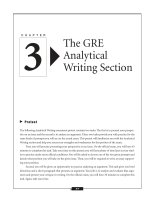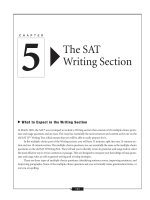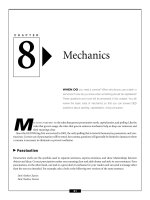The complete solution IELTS writing (luyện IELTS WRITING từ 5,5 lên band 8)
Bạn đang xem bản rút gọn của tài liệu. Xem và tải ngay bản đầy đủ của tài liệu tại đây (6.14 MB, 159 trang )
ZIM is an IELTS Training Institution with high
teaching quality under written guarantee.
With many experts in training students of
non-English speaking countries to achieve
different international certificates, ZIM
carries out the mission of making English the
second official language in Vietnam. For each
course and program, ZIM provides students
with constant and high quality support as an
endeavor to assist them to become
successful in the real tests. Apart from
official hours with teachers, ZIM also supply
students with self-studying materials which
are either collected from trusting sources or
composed by our professional staff. For
putting such priority on quality of each hour
of learning, ZIM receives non-stop advocacy
and is a trustworthy institution in training.
Key and Explanation Cambridge IELTS Reading Test –
Free Download –
IELTS Writing Task 2 – IELTS Simon’s Essay Analysis –
Free Download –
The Complete Solution IELTS Writing –
Free Download –
The Complete Solution IELTS Writing
Premium Version ( 29USD – 49 USD – 99 USD) –
SELF STUDY RECOURCES At
Foreword
This book has been written to provide students who are preparing for the IELTS
exam with a brief summary of how to write a report in the first part and to write an
effective essay in the second part of the IELTS writing section. It helps IELTS learners
have thorough insights into the structure as well as the style necessary to answer a
variety of different types of writing that commonly appear in the exam.
The way this book is organized is quite clear and simple. The general understanding
of the task’s requirements and a common structure used to write every type of essay
in the IELTS writing task 1 & 2 will be primarily presented in order for students to grab
hold of the overall idea of how they should divide their essays into a few key
paragraphs. Then the complete guidance of how to ace each particular type of essay
will instruct students to effectively study for the real exam.
This small guide only acts as a self-studying material and a supplement for students’
IELTS writing courses. Therefore, it is not recommended that students only take this
book, albeit helpful and valuable, as a sole source of preparation. Non-stop effort
and diligence result in success in the real exam!
This book is copyright © 2016 by . It is the product of considerable hardwork and the intellectual property of the author Nguyen Anh Toan and the Staff of
ZIM Institute. It is widely accessible to any students of intermediate or advanced
level. Therefore, no part of this work, in whole or in part, may be printed, copied,
distributed or sold without the written permission of the author.
1
Contents
Foreword.......................................................................................................................................................1
IELTS WRITING TASK 1................................................................................................................................. 4
CHAPTER 1 .................................................................................................................................................... 5
What you need to know about the IELTS writing task 1 ............................................................................ 5
CHAPTER 2................................................................................................................................................ 105
General structure ..................................................................................................................................... 105
CHAPTER 3.................................................................................................................................................107
How to write all types of IELTS writing task 1 .........................................................................................107
I.
II.
Line graph ............................................................................................................................... 108
Pie chart ................................................................................................................................... 112
III. Bar chart .................................................................................................................................. 115
IV. Table ........................................................................................................................................ 116
V.
Mixed ....................................................................................................................................... 119
VI. Maps ........................................................................................................................................120
VII. Process .................................................................................................................................... 121
IELTS WRITING TASK 2 ............................................................................................................................. 122
CHAPTER 1 ................................................................................................................................................. 123
What you need to know about the IELTS writing task 2 ........................................................................ 123
CHAPTER 2.................................................................................................................................................134
Sharpening your writing skills ..................................................................................................................134
CHAPTER 3.................................................................................................................................................145
General structure ......................................................................................................................................145
I.
II.
How to write a good introduction? ........................................................................................147
How to write a body paragraph?........................................................................................... 149
III. How to write a good conclusion? ........................................................................................... 152
CHAPTER 4 ................................................................................................................................................154
How to write all types of IELTS writing task 2 .........................................................................................154
I.
Opinion essay ..........................................................................................................................155
2
One-sided approach ....................................................................................................................... 156
Balanced approach ........................................................................................................................ 165
One-sided v.s Balanced .................................................................................................................. 170
II.
Discussion essay ......................................................................................................................174
III. Advantage & Disadvantage essays ........................................................................................182
IV. Cause & Effect/Solution essays ............................................................................................. 187
V.
Direct-question essays ........................................................................................................... 190
CHAPTER 5................................................................................................................................................ 193
Top 10 frequently asked questions ......................................................................................................... 193
CHAPTER 6 ............................................................................................................................................... 196
IELTS Writing task 2 review - 2016 ........................................................................................................... 196
CHAPTER 7................................................................................................................................................ 235
Essay topics to practice at home ............................................................................................................ 235
Final words ............................................................................................................................................... 242
3
IELTS WRITING
TASK 1
4
CHAPTER 1
What you need to know about the IELTS writing task 1
5
1. General introduction
-
This is the first part of the writing section which makes up one third of the overall
-
Candidates are required to write a report on a given info graphic of at least 150
band score.
words or more within suggested 20 minutes.
2. Assessment criteria
Your writing will be assessed on 4 different criteria, each of which is worth 25% of
your total marks for task 1.
TA
Task achievement
CC
LR
Coherence & Cohesion
Lexical resource
GRA
Grammatical range &
accuracy
The examiner will check
Your organization of
Your use of vocabulary,
You will get a band score
overview, detail and
paragraphing, and your
number of mistakes will
structures, tenses,
your information,
accuracy.
information, your
use of linking devices will
be marked.
your spelling and the
affect your score.
for your sentence
control of grammar and
the number of mistakes.
3. IELTS writing task 1 band descriptors
-
TA: Task Achievement
Band
9.0
8.0
7.0
Requirements
- Fully satisfies all the requirements of the task
- Clearly presents a fully developed response
- Covers all requirements of the task sufficiently
- Presents, highlights and illustrates key features/bullet points clearly and appropriately
- Covers the requirements of the task
- (Academic) Presents a clear overview of main trends, differences or stages
6
- (General training) presents a clear purpose, with the tone consistent and appropriate
- Clearly presents and highlights key features/bullet points but could be more fully extended
- Addresses the requirements of the task
6.0
- (Academic) Presents an overview with information appropriately selected
- (General) Presents a purpose that is generally clear; there may be inconsistencies in tone
- Presents and adequately highlights key features/bullet points but details may be irrelevant,
inappropriate or inaccurate
- Generally addresses the task; the format may be inappropriate in places
- (Academic) Recounts detail mechanically with no clear overview; there may be no data to
5.0
support the description
- (General training) may present a purpose for the letter that is unclear at times; the tone may
be variable and sometimes inappropriate
- Presents, but inadequately covers, key features/bullet points; there may be a tendency to
focus on detail
- Attempts to address the task but does not cover all key features/bullet points; the format
may be inappropriate
4.0
- (General training) Fails to clearly explain the purpose of the letter; the tone may be
inappropriate
- May confuse key features/ bullet points with detail; parts may be unclear, irrelevant,
repetitive or inaccurate
3.0
- Fails to address the task, which may have been completely misunderstood
- Presents limited ideas which may be largely irrelevant/repetitive
2.0
- Answer is barely related to the task
1.0
- Answer is completely unrelated to the task
Does not attend
0
Does not attempt the task in any way
Writes a totally memorized response
7
-
CC: Coherence & Cohesion
Band
9.0
8.0
Requirements
- Uses cohesion in such a way that it attracts no attention
- Skillfully manages paragraphing
- Sequences information and ideas logically
- Manages all aspects of cohesion well
- Use paragraphing sufficiently and appropriately
7.0
- Logically organizes information and ideas; there is clear progression throughout
- Uses a range of cohesive devices appropriately although there may be some under-/over-use
- Arranges information and ideas coherently and there is a clear overall progression
6.0
- Uses cohesive devices effectively, but cohesion within and/or between sentences may be
faulty or mechanical
- May not always use referencing clearly or appropriately
5.0
- Presents information with some organization but there may be a lack of overall progression
- Makes inadequate, inaccurate or over-use of cohesive devices
- May be repetitive because of lack of referencing and substitution
4.0
3.0
2.0
1.0
0
- Presents information and ideas but these are not arranged coherently and there is no clear
progression in the response
- Uses some basic cohesive devices but these may be inaccurate or repetitive
- Does not arrange ideas logically
- May use a very limited range of cohesive devices, and those used may not indicate a logical
relationship between ideas
- Has very little control of organizational features
- Fails to communicate any message
Does not attend
Does not attempt the task in any way
Writes a totally memorized response
8
-
LR: Lexical Resource
Band
Requirements
9.0
- Uses a wide range of vocabulary with very natural and sophisticated control of lexical
features; rare minor errors occur only as ‘slips’
- Uses a wide range of vocabulary fluently and flexibly to convey precise
8.0
meanings
- Skillfully uses uncommon lexical items but there may be occasional inaccuracies in word
choice and collocation
- Produces rare errors in spelling and/or word formation
7.0
- Uses an adequate range of vocabulary for the task
- Attempts to use less common vocabulary but with some inaccuracy
- Makes some errors in spelling and/or word formation, but they do not impede
communication
6.0
- Uses an adequate range of vocabulary for the task
- Attempts to use less common vocabulary but with some inaccuracy
- Makes some errors in spelling and/or word formation, but they do not impede
communication
5.0
4.0
3.0
- Uses limited range of vocabulary, but this is minimally adequate for the task
- May make noticeable errors in spelling and/or word formation that may cause some
difficulty for the reader
- Uses limited range of vocabulary, but this is minimally adequate for the task
- May make noticeable errors in spelling and/or word formation that may cause some
difficulty for the reader
- Uses only a very limited range of words and expressions with very limited control of
word formation and/or spelling
- Errors may severely distort the message
2.0
- Uses an extremely limited range of vocabulary; essentially no control of word formation
1.0
- Can only use a few isolated words
0
and/or spelling
Does not attend
Does not attempt the task in any way
Writes a totally memorized response
9
-
GRA: Grammatical Range & Accuracy
Band
Requirements
9.0
- Uses a wide range of structures with full flexibility and accuracy; rare minor errors occur
8.0
7.0
6.0
5.0
only as ‘slips’
- Uses a wide range of structures
- The majority of sentences are error-free
- Makes only very occasional errors or inappropriacies
- Uses a variety of complex structures
- Produces frequent error-free sentences
- Has good control of grammar and punctuation but may make a few errors
- Uses a mix of simple and complex sentence forms
- Makes some errors in grammar and punctuation but they rarely reduce communication
- Uses only a limited range of structures
- Attempts complex sentences but the these tend to be less accurate than simple sentences
- May make frequent grammatical errors and punctuation may be faulty; errors can cause
some difficulty for the reader
4.0
- Uses only a very limited range of structures with only rare use of subordinate clauses
- Some structures are accurate but errors predominate, and punctuation is often faulty
3.0
- Attempts sentences forms but errors in grammar and punctuation predominate and
2.0
- Cannot use sentence forms except in memorized phrases
1.0
0
distort the meaning
- Cannot use sentence forms at all
Does not attend
Does not attempt the task in any way
Writes a totally memorized response
Common types of IELTS writing task 1
-
Line graph
-
Pie chart
-
Bar chart
-
Table
-
Mixed
-
Maps
-
Process
4. Important notes:
-
No contractions
-
Always paraphrase where possible
-
No “I” or “you”
DON’T include any personal opinions
DON’T try to include everything
Writing an overview is a must
Be careful of verb tenses
Try to write 4 paragraphs
CHAPTER 2
General structure
The 3-paragraph structure can be applied to write a report in the first part of the
IELTS writing section.
Introduction
Detail
paragraph 1
Detail
paragraph 2
•Paraphrase the rubric* (see how to paraphrase in page )
•Summarize the main trends or the most remarkable featres
•Describe the main features
•Describe the main features
It is important to keep in mind that writing an overview (the summary of the main
trends and the most remarkable features) is a must.
What is “the rubric”?
Every chart, graph, table or diagram has a sentence that describes what the info
graphic is about. That sentence is called “the rubric”.
Example:
The line graph below shows the unemployment rate in Vietnam from 1990 to
2010.
CHAPTER 3
How to write all types of IELTS writing task 1
I. Line graph
The graph below shows the consumption of fish and some different kinds of meat in
a European country between 1979 and 2004.
The line graph above illustrates the amount of fish and three other kinds of meat
namely lamb, beef and chicken that people of a European country consumed during
the period of 1979 and 2004. Overall, the consumption of fish showed small degree
of fluctuation; meanwhile, the figure for Lamb, Beef and Chicken changed
dramatically from the year of 1979 to 2004.
Starting with more than 50 grams for each individual per week in 1979, the amount of
Fish slightly declined for the next five years until 1984, followed by fifteen years of
stability. In 1999, this amount decreased a little and then nearly remained unchanged
until 2004.
However, Lamb and Beef consumption with very high starting points of 150 grams
and more than 200 grams per person per week respectively experienced many years
of up and down and had the main tendency to diminish up to the year of 2004. Unlike
these two kinds of food, the consumption of Chicken with a rather lower start than
Lamb tended to soar and reached its peak of more than 250 grams for each person a
week in 2003 and stopped in 2004 with a small decline.
Analysis:
-
The introduction
The line graph above illustrates the amount of fish and three other kinds of meat
namely lamb, beef and chicken that people of a European country consumed during
the period of 1979 and 2004. Overall, the consumption of fish showed small degree of
fluctuation; meanwhile, the figure for Lamb, Beef and Chicken changed dramatically
from the year of 1979 to 2004.
Sentence 1: ‘The line graph above illustrates the amount of fish and three other
kinds of meat namely lamb, beef and chicken that people of a European country
consumed during the period of 1979 and 2004’ is the paraphrase of the rubric:
The graph below shows the consumption of fish and some different kinds of
meat in a European country between 1979 and 2004.
Sentence 2: ‘Overall, the consumption of fish showed small degree of
fluctuation; meanwhile, the figure for Lamb, Beef and Chicken changed
dramatically from the year of 1979 to 2004’ is the summary of the main trends
of the four lines.
-
Detail paragraph 1
Starting with more than 50 grams for each individual per week in 1979, the amount of
Fish slightly declined for the next five years until 1984, followed by fifteen years of
stability. In 1999, this amount decreased a little and then nearly remained unchanged
until 2004.
Describe how the consumption of Fish changed over the given period.
-
Detail paragraph 2
However, Lamb and Beef consumption with very high starting points of 150 grams and
more than 200 grams per person per week respectively experienced many years of up
and down and had the main tendency to diminish up to the year of 2004. Unlike these
two kinds of food, the consumption of Chicken with a rather lower start than Lamb
tended to soar and reached its peak of more than 250 grams for each person a week in
2003 and stopped in 2004 with a small decline.
Describe how the consumption of the other types of food over the given
period
Note:
- Don’t give numbers in the summary sentence
- Try not to describe the lines separately. Try to make comparisons where
possible.
- Use past tenses for past years, and use future tenses for future years.
- Don’t use the passive, continuous or perfect tenses.
Language of change:
To plummet/plunge
To peak
To hit a peak
To drop
sharply
To decrease
dramatically
To fall
To reach a peak
To decline
To rocket/surge
To increase
sharply
To rise
To climb
To fall
To decline
dramatically
1
significantly
To drop
4
rapidly
rapidly
6
2
gradually
slightly
minimally
7
8
3
To remain
the same
5
unchanged
stable
To
gradually
increase
slowly
rise
minimally
To fluctuate
(wildly)
To stabilize
To reach the lowest point
To hit the bottom
To level off
To remain constant









